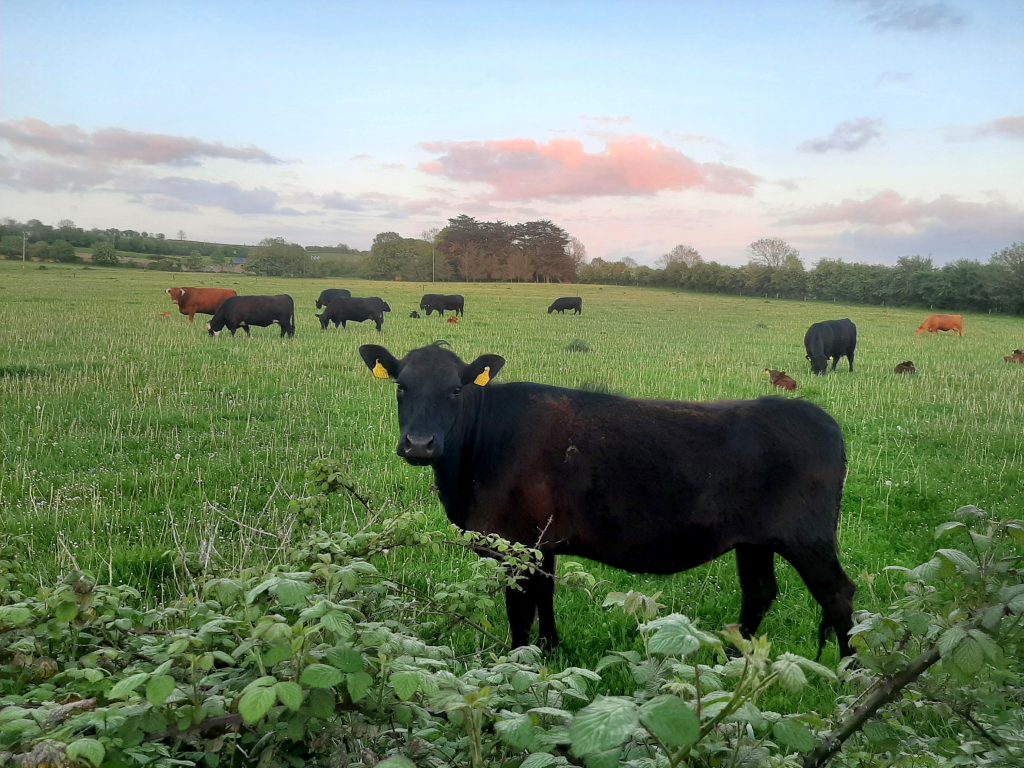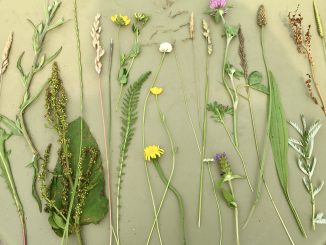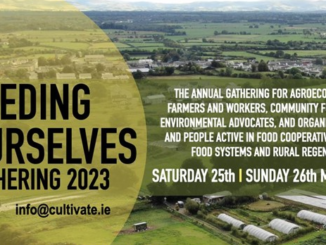
A common criticism of ‘animal agriculture’ is that it uses human-grade food as a feedstock. It is also heard in Ireland, a country with a significant livestock population by European standards. To what extent is it true that animal agriculture uses human-grade food? Further, and actually the important issue, is what amounts of artificially created, plant-growing nutrients are directly used to grow animal feed? It is an issue that becomes yet more important when diets change and animals become ‘urbanised’ – divorced from the land that feeds them. Stuart Meikle with part 3 of his series on Ireland, Food Security and Feeding the World.
Humans cannot eat grass, obviously, but they can consume grains, pulses and oilseeds directly. Should we be dedicating land to growing these crops to feed animals? We also need to differentiate between the diet of grazed herbivores and housed omnivores and whether animals consume or create fertility in farmed soils. And to what degree are animals fed by-products of the food-processing industries?
Ultimately it is plant nutrient availability that will dictate system choice. The focus will move to animals that can be connected to the land and to their role in cycling and naturally introducing nutrients into human food supply chains. It will be about soil fertility building. It will also be about the recycling of food wastes back to the land through animals [a cycle currently disabled with respect to the direct feeding of food wastes to omnivores for biosecurity reasons, leaving composting as the solution].
This article is about informing the debate. The information in it has long been needed. It is, however, still superficial and no more than a snapshot. It has also required the author to resort to available ‘standard’ farm management data to make predictions. The information it contains is, therefore, only indicative but, overall, the article highlights the information needed and ‘the direction of travel’.
Ireland’s typical feed supply
The estimates are based on FAO data from 2018 to 2020, allowing for 2018 having a fodder crisis. The years 2019 and 2020 are considered typical and 2018 a high import year. A historical assessment since say 2010 would reveal more about how dairy and pig sector expansion has influenced feed imports.
TOTAL IRISH FEED IMPORTS FOR 2018 TO 2020
| 2018 | 2019 | 2020 | Now? | |
| Grains [after human use adjustment] | 1,820,905 | 1,278,071 | 1,000,377 | 1,300,000 |
| Proteins | 1,195,973 | 927,703 | 1,122,052 | 1,125,000 |
| Other | 1,724,475 | 1,200,216 | 1,204,832 | 1,300,000 |
| Total Feed Use Imports | 4,741,353 | 3,405,990 | 3,327,261 | 3,725,000 |
The above figures sourced from the FAO are net of not insignificant animal feed exports [likely cross-border] to the UK.
In 2018 there was a major fodder crisis. Its impact could illustrate what could happen with a nitrogen shortage as in 2022. In 2018, fodder shortfalls were met with increased feed imports [with soya hulls (needed to balance ruminant rations) being included under ‘Other’]. The higher domestic grain harvest of 2019 would be reflected in lower imports in 2020’s early months. Thus, given the on-going animal-sector expansion, the grain imports for 2020 could have been, say, 200,000 tonnes or so higher.
It should be noted that proteins may include some soymeal destined for human-use food products. In Ireland it could be 50,000 tonnes, but accuracy requires an assessment of the food processing sector. For simplicity, this is ‘balanced’ as being equivalent to domestic production of peas and beans for feed.
The above table estimates the current position with the total grain figures being adjusted [minus 350,000 tonnes] for human use [flour use is around 500,000 tonnes, of which only 5% is locally grown]. Wheat is imported for mills in Ireland, but it is believed that the only one left functioning at scale is in Portarlington. About 200,000 tonnes of flour is imported to Ireland. The reason is the grain-quality needs of the Chorleywood Bread Process, which produces consumer-friendly soft white fluffy breads quickly.
The 350,000-tonne deduction will also include primarily barley destined for brewing and distilling.
ADDING IN DOMESTIC GRAIN PRODUCTION
| 2018 | 2019 | 2020 | Now? | |
| Grains [after human use adjustment] | 1,820,905 | 1,278,071 | 1,000,377 | 1,300,000 |
| Proteins | 1,195,973 | 927,703 | 1,122,052 | 1,125,000 |
| Other | 1,724,475 | 1,200,216 | 1,204,832 | 1,300,000 |
| Total Feed Use Imports | 4,741,353 | 3,405,990 | 3,327,261 | 3,725,000 |
| Domestic Grain Harvest | 1.784,900 | 2,267,990 | 1,892,640 | 2,000,000 |
| Minus Human Use | 350,000 | 350,000 | 350,000 | 350,000 |
| Residual Used for Feed | 1,434,900 | 1,917,990 | 1,542,000 | 1,650,000 |
| Total Feed Used | 6,176,253 | 5,323,980 | 4,869,261 | 5,375,000 |
| Self-sufficiency in feed | 23% | 36% | 32% | 31% |
PIG AND POULTRY PRODUCTION USAGE
There is little published information about what grains, proteins and food-processing ‘wastes’ are fed to what animals. Comment rarely goes beyond the gross import figure. Thus, an attempt has been made to provide some detail. The starting point was to estimate the likely feed fed to omnivores as, unlike with ruminant farming, the mainly indoor systems are less variable in their needs. Feed is by far the major variable (or direct) cost and, hence, price and availability dictates production economics.
Using available production figures, the following estimates have been made for the current situation.
- Pigmeat production needs about 1.3 million tonnes
- Poultry meat farms require around 400,000 tonnes
- Egg-laying hens will consume about 100,000 tonnes
Therefore, an approximate estimate is that omnivore consume is about 1.8 million tonnes. If 20% is taken as proteins [most likely soymeal] the split will be 360,000 tonnes proteins and 1,440,000 grains, a significant proportion will be maize [900,000 tonnes assuming a 50% diet inclusion rate]. It should be reiterated that these are only approximations, and a detailed study is required to create accuracy.
As indoor production varies less the above are used as a constant to predict the feed fed to ruminants.
Thus, there would be an expected ruminant feed grains requirement of about 3,575,000 tonnes. It is, however, likely that the level of self-sufficiency in feed for ruminants is far higher with home-grown grains predominating. In addition some food processing wastes are sourced from Ireland’s neighbour.
BREAKDOWN OF FEED GRAIN IMPORTS
| 2018 | 2019 | 2020 | Now? | |
| Grains [after human use adjustment] | 1,820,905 | 1,278,071 | 1,000,377 | 1,300,000 |
| Wheat | 255,658 | 92,922 | 55,103 | 50,000 |
| Barley | 300,216 | 38,360 | 107,873 | 90,000 |
| Oats | 7,844 | 11,364 | 11,018 | 10,000 |
| Maize | 1,317,322 | 1,284,190 | 979,126 | 1,150,000 |
The key direct suppliers of maize were Canada [34%], Ukraine [25%] and Brazil [18%]. Another 14% from the same countries came via the UK. The 2020 imports were lower because of the good Irish 2019 grain harvest.
BREAKDOWN OF PROTEIN IMPORTS
| 2018 | 2019 | 2020 | Now? | |
| Proteins | 1,195,973 | 927,703 | 1,122,052 | 1,125,000 |
| Cake, palm kernel | 201,818 | 71,520 | 106,705 | 100,000 |
| Cake, rapeseed | 247,738 | 192,259 | 222,966 | 200,000* |
| Cake, soybeans | 575,010 | 537,789 | 691,541 | 700,000 |
| Cake, sunflower | 131,202 | 88,458 | 80,719 | 100,000 |
| Cake, others | 40,205 | 37,677 | 20,121 | 25,000 |
* Likely to be on a downward trend due to lower UK oilseed rape production. More recent CSO figures will be assessed in due course.
Of the above the palm kernel cake was sourced from Indonesia and Malaysia. The rapeseed cake was from Germany, France, Belgium and the UK. Soybean cake was mainly directly sourced from Argentina [60%] or via the UK first. Sunflower cake came from various European countries. All are co- or by-products to vegetable oil.
BREAKDOWN OF OTHER FEED IMPORTS
| 2018 | 2019 | 2020 | Now? | |
| Other | 1,717,596 | 1,193,289 | 1,189,239 | 1,300,000 |
| Sugar beet pulp | 272,867 | 133,000 | 184,072 | 150,000 |
| Bran from wheat | 302,546 | 208,307 | 238,606 | 250,000 |
| Food by-products | 1,142,183 | 851,982 | 766,561 | 900,000 |
The first two are sourced from several countries while food by-products include distillers’ and brewers’ grain, fruit [including citrus] pulp and soya hulls. The three main suppliers being the USA, the UK and Argentina. The exact product make-up of ‘food by-products’ imports needs further breakdown but citrus pulp and soya hulls are important sources of digestible fibre for ruminants, especially so in years where home-grown fodder is short. The higher imports of food by-products in the fodder crisis year of 2018 reflects this need to balance ruminant rations.
The author is unaware of a study that subdivides feed imports to livestock sector. Such would inform the debate over the sustainability of the different sectors. The following is an approximation based on likely on-farm usage for pigs and poultry and that such is supplied solely from grains and proteins.
FEED USAGE BREAKDOWN BY SECTOR
| Now? | Pigs | Poultry | Ruminants | |
| Grains | 2,950,000 | 1,040,000 | 400,000 | 1,510,000 |
| Proteins | 1,125,000 | 260,000 | 100,000 | 765,000 |
| Other | 1,300,000 | 0 | 0 | 1,300,000 |
| Total Feed Used | 5,375,000 | 1,300,000 | 500,000 | 3,575,000 |
The above needs substantiating, but it indicates what is needed to answer the question “does Ireland feed food? It is likely that pigs and poultry are import dependent while local barley feeds ruminants.
It is possible that the pig and poultry sectors consume nearly half of all feed imports and up to three-quarters of grain and protein imports. Ireland could be growing enough barley for its ruminant sector, but it still requires significant imported proteins and, for dietary fibre, soya hulls and citrus pulp.
While grains may all be considered as ‘food’, in some cases what is fed is not of human-food grade – or has failed to meet the specifications. Growing directly for animal feed is, however, common practice.
The protein meals are by-products of crushing seeds for oil. With soya, the meal is a significant part of the total income received for the beans. The meal and oil are, de facto, co-products. Such is less the case for rapeseed while palm kernel meal is a tiny proportion of the palm fruit and its final products.
The loose term used by the FAO for food-processing by-products is ‘waste’, even though they are used as animal feeds. Such would suggest that they would not be produced if it was not for the demand for the primary product. These include fruit pulp, sugar beet pulp, bran from milling, and soybean hulls.
General Marketing Issues Arising
If Ireland is going to seek to sell more livestock products into discerning markets, feed provenance is likely to rise in importance. To what degree is Irish, ‘Irish’ when it is mainly grown with imported feeds?
The use of GM (Genetically Modified) feeds may become a greater issue. The issue may not be country specific but dictated by the demands of individual retailers or food service customers. It is probable that at least 90% of soymeal imports originates in Argentina where soya is 100% GMO. Even if the pig and poultry sectors are the main users of soymeal, its use in ruminant rations will not be insignificant. Add in soya hulls and a significant quantity of GM soya-based feeds are being fed to ruminants. Where the maize fed is of Brazilian or Canadian origin, those feeds may also be from genetically modified maize crops.
Finally, care has to be taken over the use of the term ‘grass-fed’. Typically, on a dry-matter basis Irish dairy is around 82-83% grass-fed. This will fall in poorer forage years. The need to use soya hulls to add fibre in such circumstances may then compromise ‘grass-fed’ and ‘GM-free’ marketing claims.
Our next and final section, part four, will address Ireland’s own food security.
More
Part 2 | Ireland, Food Security & Feed(ing the World) – Ireland and the Archipelago
CAP Strategic Plans and Food Security: Fallow Lands, Feeds, and Transitioning the Livestock Industry
Long Read | How to Feed the World Without Killing the Planet?





